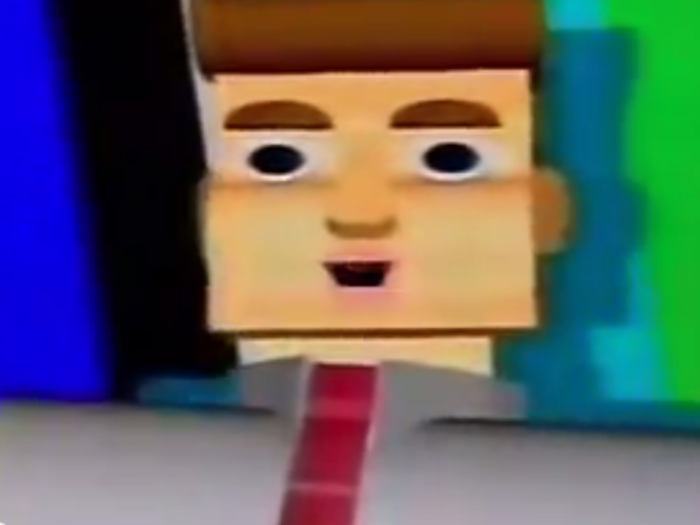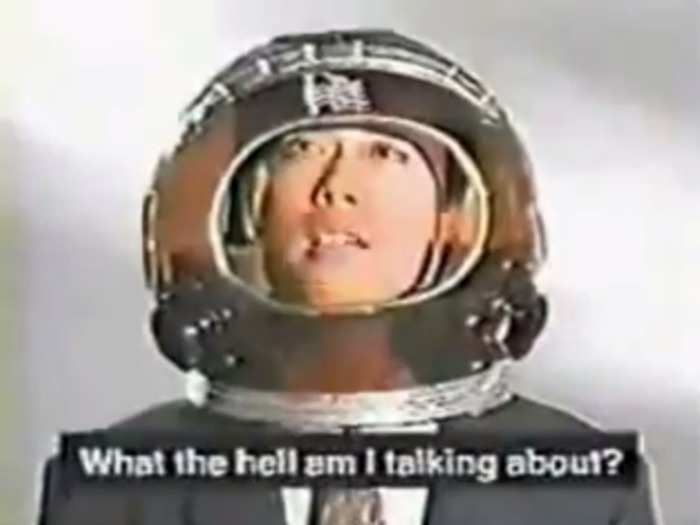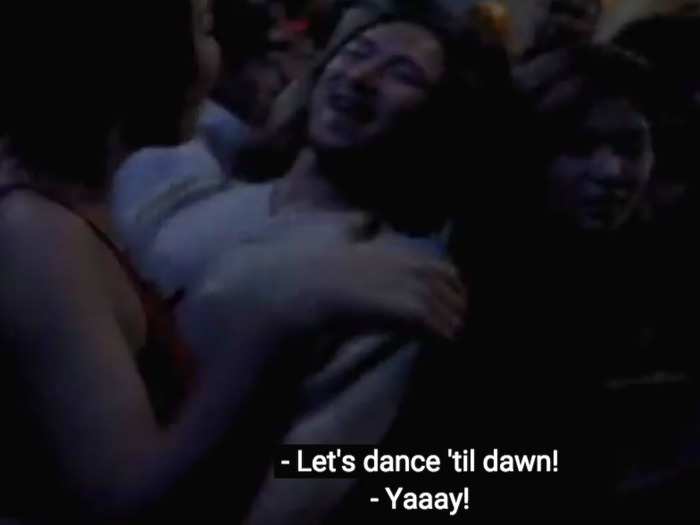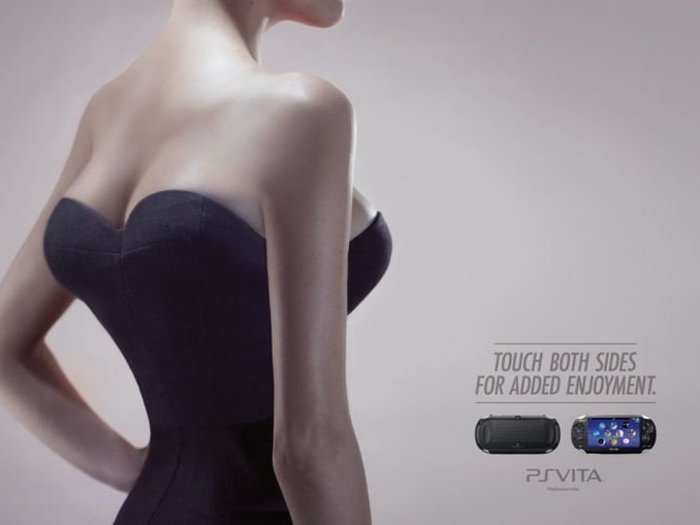- Home
- entertainment
- Video Games
- 15 shocking video ads from the 80s and 90s
15 shocking video ads from the 80s and 90s
Nintendo tried to sell the Game Boy Pocket with a six-tongued wall of flesh.

While its menacing TV commercials lured fans into buying Nintendo games.

So you put down the magazine and flip on the television, but Nintendo follows you across media. This ad, with its threatening script, paleo-CGI characters, and rasping digital voices wouldn't have made me feel any better about the company.
In fact, it seems to operate under the premise that video game companies should present themselves to customers as horrible enemies to overcome. Text cannot convey the full creepiness of the (alligator? dinosaur?) creature intoning "You ... cannot ... beat ... us." over and over in front of a cathode-ray television flashing with video games, so you'll just have to watch it for yourself:
http://www.youtube.com/embed/eX4MdXF3OWI
Width: 800px
Height: 450px
Would you want to play Nintendo games after watching this? I think I'd be hiding under the bed with a nice book.
Sony, meanwhile, brilliantly subverted American xenophobia for its own advertisements.

Nintendo didn't have a lock on the bizarre video game ads market, nor were all bizarre ads terrible. In 1995, after a decade of Americans fearing a "corporate Japanese takeover," Japanese electronics firm Sony ran this commercial to push its fledgling PlayStation.
The ad played on and gently satirized American fears of invading Japanese businessmen, but was goofy enough to be funny without that subtext.
Its message (delivered by a man in a business suit speaking Japanese) is summed up early on:
"Do you suppose a smart company like Sony would invest millions of dollars in the PlayStation, only to launch it with a bunch of games that suck?"
The man has a point. And you know he's an authority, because he tells you this:
The genius of this commercial is that it operates on three levels. If your boogeyman really is a Japanese man in a suit, seeing this guy make a fool of himself might undercut your fears (and make you more comfortable buying a Japanese product). If you are just an interested fan worried the PlayStation won't have any good games, it allays those fears as well. And it does all that while serving as a wink and a nod across a linguistic, cultural, and possibly racial boundary.
"Real Japanese guy" immitates silly '90s-era American idioms:
Then tries (and fails) at some martial arts:
And, just for kicks, he shows off his racing skills:
You can watch the full video below:
http://www.youtube.com/embed/nFQwwpMh2mU
Width: 800px
Height: 600px
A few years earlier, Nintendo used a racist caricature to sell "Dr. Mario."

Where that Sony commercial played on the disconnect between Japanese manufacturers and American consumers, this Nintendo ad for the 1990 game "Dr. Mario" dived into flat-out racism.
The TV spot features a shrunken-headed white teenager singing a rewritten verson of the violently catchy 1958 novelty earworm "Witch Doctor." Meanwhile, a brown-skinned man dances around and pulls faces in a costume drawing on nasty Western caricatures:
http://www.youtube.com/embed/rSYfo8PwLQU
Width: 800px
Height: 600px
"Oo-ee-oo-ah-ah-ting-tang-wadda-wadda-bing-bang," a helpful voice-over informs us, means, "play 'Dr. Mario' on NES."
And yes, this really is racist. Entertainers have a long history of minstrelsy – exploiting and performing caricatures of "exotic" people to sell tickets, books, political ideologies, or, in this case, video games. When a 2009 chain email bashing Barack Obama circulated online, it featured the president photoshopped into an almost identical costume.
Witch doctors don't actually have anything to do with "Dr. Mario," except for the word "doctor." Instead, this ad serves the same purpose as any other bizarre TV spot: the people making this ad for Nintendo hoped the caricature would stick in kids' heads long enough for them to go out and buy the game.
The ad closes with the white teenager besting the "witch doctor" in "Dr. Mario," and the teen telling us that's how he ended up with a shrunken head.
Get it? Get it?
The Sega Game Gear: better than hitting yourself over the head with petrified roadkill!

http://www.youtube.com/embed/EVQ1fP7dNEE
Width: 800px
Height: 450px
While Sony sold the PlayStation on the quality of its games, and Nintendo went for ... memorable marketing, Sega tried to convince players of its superior hardware.
The Sega Game Gear competed with the first-generation Nintendo Game Boy in the early '90s. On paper, it actually was better console in most respects. It had a 3.2-inch, 32 color screen to GameBoy's 2.6-inch green-and-slightly-darker-shade-of-green display. But at nearly double the price and with a fraction of Nintendo's game library, it was doomed.
This commercial is just one of Sega's several attempts to ridicule Game Boy players for playing on an inferior console – and shows just how deeply Sega missed the point of gaming.
In fact, if you do buy a Game Boy, Sega thinks you're a colorblind toilet-drinker.

http://www.youtube.com/embed/cieXjddmpUY
Width: 800px
Height: 600px
As a colorblind person, I want to make something clear: not all of us are toilet drinkers (#notallcolorblindpeople). This commercial has the same goal as the roadkill-bashing one, but insults players even more directly. Is it any wonder that Game Boy outsold the Game Gear by a factor of ten?
Even Nintendo's non-racist ads were incredibly cringe-inducing.

http://www.youtube.com/embed/uI3rO3PbYOo
Width: 800px
Height: 600px
This commercial is clearly self-parody to some extent. The after-school-special-y rap, the kid with the pocket protector pushing his glasses up his nose – someone involved must have known how corny this was right? That's what I choose to imagine anyway.
In either case, this '80s-era "Zelda" ad showed Nintendo following the currents of the video game industry – toward quality, exciting games – even as Sega tacked upwind into hardware.
But the question remains: could these people see themselves?
Nintendo made a six-minute ad featuring evil Sega and Sony operatives kidnapping a Nintendo parachutist and torturing Mario.

Look at that GIF. That's a Nintendo ad.
Why is Mario's head in a vice? Apparently so Sega and Sony cronies could press a Nintendo parachutist into revealing details of an upcoming "Star Fox" title. Why does a Nintendo parachutist have this information? Why did Nintendo hire a parachutist? Do Sony and Sega cronies wear their branded t-shirts on real-life torture-based corporate espionage missions?
See the ad – or "Nintendo Power feature presentation" – for yourself:
http://www.youtube.com/embed/NBF3X3ZaS2Q
Width: 800px
Height: 600px
Konami's corny ads were still better than Sega and Nintendo's corny ads.

This ad for "Metal Gear Solid" on PlayStation is refreshing. Video game maker Konami doesn't attack other publishers and players, or traffic in any awful tropes. They just make a goofy joke about the test regime for a warrior signing up for the game's dangerous mission:
This is funny, memorable, includes actual gameplay footage, and tells us something about the game. In other words, it's an early example of what video game ads should be. Watch the weird little sketch:
http://www.youtube.com/embed/smiFwL8ACNw
Width: 800px
Height: 600px
Sega invented a character to beat up people who did fun things instead of playing the Sega Saturn.

Sega's advertising in Japan took an even more insane tack. The company was trying to market its Sega Saturn console – otherwise known as the worst major console of all time. Saturn's failures would ultimately force Sega out of the console business altogether, but when the infamous "Segata Sanshiro" ads ran on Japanese television, that future wasn't yet clear.
The ads were actually pretty funny as oddball comedy setpieces, even as they laid bare so many of Sega's corporate insecurities. Each began with a group of people doing something fun other than playing video games on the Sega Saturn. In the universe of these ads, that was a sin to be punished. And Segata Sanshiro was just the man to do it.
Sanshiro's name was a pun on the titular character in legendary Japanese director Akira Kurosawa's debut film "Sanshiro Sugata." Sugata/Segata. Get it? Non-Saturn players greet Segata's macho-magical arrival with terror – apparently his reign of terror is well known – before he strangles them and leaves their injured bodies in a pile on the ground:
The whole thing comes across more like a hilarious mockery of Sega than an incentive to buy their failing product.
Here's how Sanshiro handled a group of young kids who dared to wish for non-Saturn gifts for Christmas:
Fortunately, the childrens' youth (or maybe their tears?) saves them from a beating. Instead, Sanshiro seems to be doing more of a "scared straight" thing. Cowed by the threat of judo violence, the kids end the commercial with grins plastered on their faces and a Saturn clutched in their terrified little hands.
You can watch an English-captioned compilation of many of the Sanshiro spots below:
http://www.youtube.com/embed/gc3AK8k90xw
Width: 800px
Height: 450px
This ad for the first 'Smash Bros.' featured live-action Nintendo characters beating each other up in a field.

Nintendo did produce some similarly lovely, bizarre ads around the same time. In an effort to counter Sega's image as the more "grown up" video game company, the ad sold "Super Smash Bros." as a break from the "happy-go-lucky" world of Nintendo.
The commercial trippily cuts back and forth between live-action and gameplay footage, accomplishing the same feat as the "Metal Gear" ad: it's instantly memorable, strange, and shows you footage from the actual game.
http://www.youtube.com/embed/K783SDTBKmg
Width: 800px
Height: 600px
Sega's 'Theatre of the Eye' commercial was a post-modern swirl of hilarity and horror.

Segata Sanshiro never made it to America. Instead, Sega marketed the Saturn with a bizarre extended metaphor for the internal experience of playing their console. Its premise: Saturn's hardware is so good it will do actual harm to your body.
This commercial may have that affect, though I suggest watching it anyway:
http://www.youtube.com/embed/cP3ciD4Efr0
Width: 854px
Height: 510px
The Japanese rapping 'Legend of Zelda' ad was way better than the American rapping 'Legend of Zelda' ad.

Segata Sanshiro may not have crossed the Pacific ocean, but the "rapping Zelda ad" concept did. The Japanese version of the ad is probably the most amazing TV commercial ever made to sell a video game.
It features a bored-looking Link leading a hypnotizing dance based on the game's animations:
A puppet version of the demon pig-boss Ganondorf:
And a crazy dance remix of the ridiculously catchy music from the classic game. There isn't a moment of this commercial that isn't worth watching:
http://www.youtube.com/embed/u3THavMxNDE
Width: 800px
Height: 600px
Meanwhile, an ad for this Nintendo 64 game featured a woman getting intimate with a squirrel.

Speaking of "grown up" Nintendo games ... unfortunately no list of bananas '90s video game ads would be complete without this video. "Conker's Bad Fur Day" was a product of its time, attempting to be edgey at all costs. I'm all for edgey, sexy art, but "Conker's Bad Fur Day" didn't deal in edge so much as wallow in sludge – the sort of story about drugs and sex you might expect from someone who had no positive real-world experience in either.
(Before the superfans jump down my throat, yes the game earned a 92/100 Metacritic score and maintains a loyal cult following.)
The ad features lazy shots of a woman's bare legs, extensive vomiting noises, and a simulated person-on-squirrel sex act. Watch at your own risk:
http://www.youtube.com/embed/5fcid8H3bbo
Width: 800px
Height: 600px
But don't worry, there's plenty of awful ads still around.

But us 2015-ers shouldn't get too smug looking back at these '90s ads. Things have gotten a bit better – mostly because game fans have developed a set of highly particular expectations from their game trailers. A typical marketing rollout begins with a separately computer-generated clip teasing the game's plot. Then, a trailer will feature footage made using the game's graphics software. Finally, an all-gameplay trailer will emerge showing players what the game actually looks like.
Still, companies regularly step over the line it to outright nastiness. Here's a Sony PlayStation Vita Remote Play ad from 2014:
http://www.youtube.com/embed/3U7LYk0woH8
Width: 800px
Height: 450px
It's funny, apparently, because the porny doctor sounds like she's talking about masturbation. Also, because "everyone" in the video game universe is a straight male teenager who obsesses over video games and women as object of sexual obsession.
This 2012 print ad for the PS Vita makes the dehumanizing conflation even more overt:
Message: breasts are to women as buttons are to video game controllers. Silly things like heads and hands are basically just unnecessarily peripherals.
Things have gotten somewhat better over the years. If nothing else, the frequency of these offensive ads has decreased. But Sony's brief detour back into poorly chosen marketing serves as a reminder: we're still not out of the woods just yet.
Popular Right Now
Popular Keywords
Advertisement